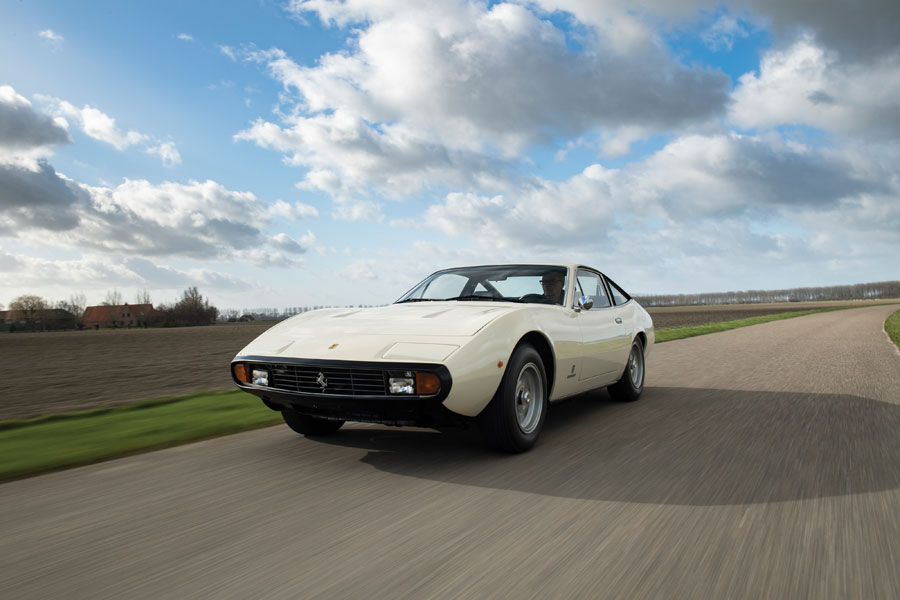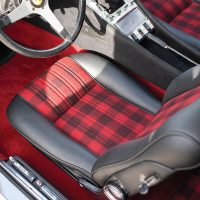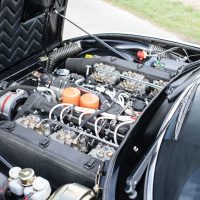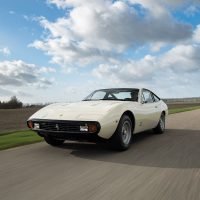SCM Analysis
Detailing
| Vehicle: | 1971 Ferrari 365 GTC/4 |
| Years Produced: | 1971–72 |
| Number Produced: | 500 |
| SCM Valuation: | $237,500 |
| Tune Up Cost: | $6,000 |
| Chassis Number Location: | Stamped plate in the engine compartment on inner left fender; top of steering column |
| Engine Number Location: | Passenger’s side of block near the rear |
| Club Info: | Ferrari Club of America |
| Website: | http://www.ferrariclubofamerica.org |
| Alternatives: | 1974–82 Maserati Khamsin, 1965–74 Iso Grifo, 1970–76 Lamborghini Jarama |
| Investment Grade: | C |
This car, Lot 367, sold for $299,587 (€264,000), including buyer’s premium, at RM Sotheby’s Online Only — The European Sale Featuring the Petitjean Collection, June 3–11, 2020.
Let’s just get this out of the way: The Ferrari 365 GTC/4 has a fatal flaw in Pininfarina’s less-than-elegant solution for meeting in-period safety standards. The two-inch chunk of rubber that surrounds the nose of a C/4 ruins the rest of the car. It catches your eye and will not let it go. That is a shame, because in all other respects, the C/4 is an exceptional car.
Defining some terms
A coupe-class Ferrari is either a two-place model or one with marginal rear seating. A Ferrari coupe is by definition more luxurious than a strictly two-place berlinetta. The coupes have a little bit more room and more creature comforts. A four-place 2+2 is bigger still, with rear seating intended to accommodate an adult.
Ferrari described the 365 GTC/4 as the replacement for two cars, the two-place 365 GTC (Grand Touring Coupe) and the four-place 365 GT 2+2. The 365 GTC had been introduced to squeeze a couple more sales out of the popular-but-aging 330 GTC. The 365 GT 2+2, as the name indicates, had a pair of adult-sized rear seats.
In the 365 GTC, Ferrari replaced the 330 GTC’s 300-horsepower 4-liter engine with the same 320-hp 4.4-liter V12 that was used for the 365 GT 2+2. While the extra 20 horses added some kick, it was the larger engine’s torque and response that earned the 365 GTC its cult following. Indeed, with three carbs the 2-cam engine has excellent low-end torque as well as freely revving to its 7,000-rpm redline. It makes wonderful sounds and provides a most pleasurable driving experience.
Both the 365 GTC and 365 GT 2+2 were traditional Pininfarina designs. The bodies featured curved panels with set-back exposed headlights and an elliptical snout. They were conservative-looking cars that were attractive but well short of avant-garde.
That ’70s style
The 365 GTC/4 was a departure. Based on the 365 GTB/4 Daytona, both cars featured Pininfarina-designed fastback styling, but the execution of the C/4 was dramatically different. The Daytona continued with the compound curves while the C/4 embraced a more modern design with a mixture of curves and the angular styling that would soon become en vogue.
Pininfarina wanted the C/4 to feature a lower profile than the Daytona and a thinner full-width nose. At the same time, U.S. crash standards were moving toward bumpers that would absorb a five-mph contact without showing damage. Designers experimented with solutions that met the standards without being obtrusive. Pininfarina chose a rubber bumper for the C/4. As I said, in all but black C4s, it ruins what is otherwise an attractive design.
The 365 GTC/4’s interior redeems the awkward snout. It features a large center console, dividing the interior into two cockpits. (Ferrari has actually just resurrected the idea in its new Roma.) The trim is plush, with liberal use of leather mixed with a faux suede. The back of the C/4’s rear seats can be folded down to hide them, the configuration most often seen.
The best-sounding Ferrari
The C/4’s mechanical configuration is also admirable. The 4.4-liter, 4-cam V12 is based on the Daytona’s engine. It is not as free-revving as the 2-cam version used in the 365 GTC and 365 GT 2+2, but it is definitely more powerful and also has an incredible sound. Many people feel the C4 is the best sounding of all Ferraris. Six side-draft Weber carburetors are used instead of the Daytona’s six downdraft carbs, to allow for a lower hood line. The side drafts and tuning rob the C/4 of 12 horses but drop the horsepower peak by 800 rpm, thus making the engine more amenable to daily driving.
Indeed, while many exotics of the period are challenging to drive, the C/4 requires little effort. A front-mounted transmission was used rather than the Daytona’s transaxle, so the shift lever goes directly into the top of the gearbox, making shifts easy and direct. Power steering means driving in town or on the road is effortless.
Around the world
Our subject C/4 has been a world traveler. Originally sold in the U.S., it spent time in Australia before making it up to the United Kingdom and on to the Netherlands. When in Australia, it is reported the car had been used as a race car. I suspect that means that it had been used in some club events as opposed to serious competition.
At one point it had been color-changed to black; however, it was subsequently changed back to its original Ivory color. The interior is black with red plaid cloth insert. Cloth inserts were standard equipment, with full leather available as an option, and the cloth actually better holds the driver in place.
A British dealer apparently commissioned a $220,000 restoration on the car, with paint, interior and mechanical work performed. Upon completion, the car received Classiche Certification. SCM’s auction reporter noted the car had “excellent paint, interior, engine compartment and chassis,” but that there were some cracks in the bumper and pitting on the door handles.
If this falls short of expectations for a $220,000 restoration, the sale price did not. A dinner tab short of $300k hit the middle of an optimistic estimate. C/4 values trail Daytonas in a bull market and lead in a bear. Daytona values have been down this year, so this sale was a bit surprising. It was an attractive car with a good story, but the price was more in line with what a low-mile survivor would bring. The buyer got a restored C/4 with all the accessories and a Classiche Red Book. The seller may not have recovered their investment but got all the money they could expect. Chalk this one up for the seller. ♦
(Introductory description courtesy of RM Sotheby’s.)



